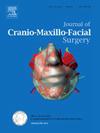Unilateral cleft lip repair: Standardized key steps for Cupid's bow reconstruction
IF 2.1
2区 医学
Q2 DENTISTRY, ORAL SURGERY & MEDICINE
引用次数: 0
Abstract
Cleft lip repair is a complex and technically demanding surgery, performed by skilled surgeons. Improving surgical outcomes in cleft lip repair offers substantial benefits to patients, yet it remains a persistent challenge for surgical teams. To address this challenge, we developed a systematic protocol based on 40 years of refinements in 7400 cases. By deconstructing the procedure into defined steps, this framework aims to reduce procedural variability while preserving flexibility for case-specific adaptations. The stepwise approach was applied to establish a surgical procedure for Cupid's bow reconstruction in unilateral cleft lip repair, providing quantified, predictable, and repeatable steps for both surgeons and surgical teams. Five empirically refined steps were defined: landmarking; descending of Cupid's peak; correction of the Cupid's bow midline; reconstruction of subanatomical structure and the white roll of Cupid's bow; and restore the symmetry and coordination of Cupid's bow. Both immediate and long-term outcomes demonstrated good and stable results in Cupid's bow reconstruction in unilateral cleft lip repair. This protocol synthesizes four decades of surgical expertise into a reproducible framework, emphasizing adaptability to anatomical diversity while reducing reliance on subjective intraoperative decisions.
单侧唇裂修复:丘比特弓重建的标准化关键步骤。
唇裂修复是一项复杂且技术要求高的手术,需要熟练的外科医生来完成。改善唇裂修复的手术效果给患者带来了巨大的好处,但这仍然是外科团队面临的一个持续的挑战。为了应对这一挑战,我们基于40年来对7400例病例的改进,制定了一套系统的方案。通过将程序分解为定义的步骤,该框架旨在减少程序的可变性,同时保留针对具体情况的适应性的灵活性。采用渐进式方法建立单侧唇裂修复中丘比特弓重建的手术程序,为外科医生和手术团队提供量化、可预测和可重复的步骤。定义了五个经过经验提炼的步骤:地标;丘比特的峰顶下降;丘比特弓中线的修正;亚解剖结构重建和丘比特弓白卷;恢复丘比特之弓的对称性和协调性。丘比特弓重建在单侧唇裂修复中的近期和远期效果均良好稳定。该方案将四十年的外科专业知识综合到一个可重复的框架中,强调对解剖多样性的适应性,同时减少对术中主观决策的依赖。
本文章由计算机程序翻译,如有差异,请以英文原文为准。
求助全文
约1分钟内获得全文
求助全文
来源期刊
CiteScore
5.20
自引率
22.60%
发文量
117
审稿时长
70 days
期刊介绍:
The Journal of Cranio-Maxillofacial Surgery publishes articles covering all aspects of surgery of the head, face and jaw. Specific topics covered recently have included:
• Distraction osteogenesis
• Synthetic bone substitutes
• Fibroblast growth factors
• Fetal wound healing
• Skull base surgery
• Computer-assisted surgery
• Vascularized bone grafts

 求助内容:
求助内容: 应助结果提醒方式:
应助结果提醒方式:


